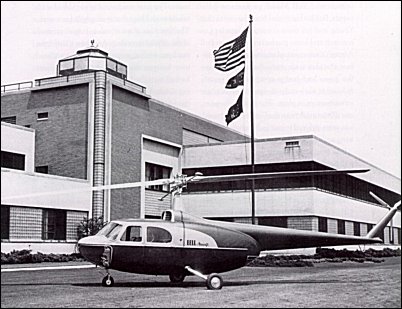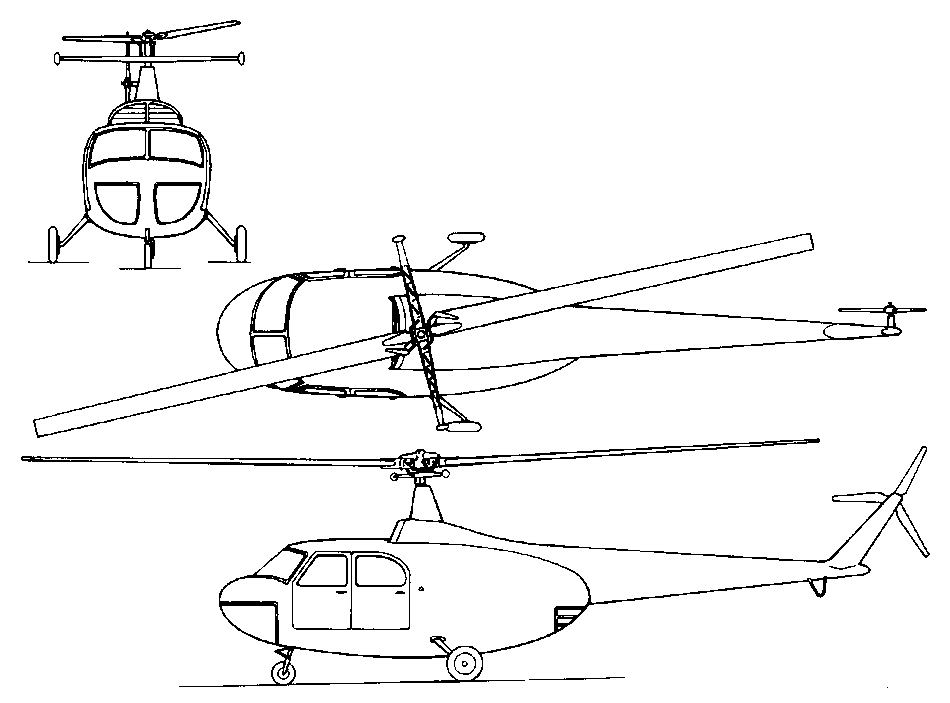Post by Stingray on Feb 28, 2008 18:56:48 GMT -4
Bell Model 42
1946
---------------------------------------------------------------------------------------

In 1946, accepting the conclusions of a marketing survey, Larry Bell asked the main engineering department of his company to develop for the civil market a much larger helicopter than the Model 47. This was the Model 42 which was in fact a very ambitious aircraft for its time and was presented by Bell Aircraft Corp as 'the helicopter of the future'. It had been calculated to cruise at 210km/h over a range of some 720km. The rather modern looking Model 42 was a streamlined all-metal helicopter which could carry five people: the pilot's and co-pilot's seat were situated in the fore part of the cabin, and a cross bench for three passengers was located aft. Access to the cabin was via two car-like doors. As powerplant Bell's engineers selected the 450hp Pratt & Whitney Wasp Junior R-985 nine-cylinder air-cooled radial. It was horizontally mounted in the rear fuselage and its adequate cooling was assured by a large airscoop located at the root of the main rotor mast. This rotor, made of wood, was of the symmetrical aerofoil section two-blade type with the now classic stabilising bar; it had a reduction gear with a ratio of 8.987:1. In addition to the free-wheeling coupling, the transmission included a rotor brake. A three-bladed anti-torque tail rotor, also made of laminated wood, was located on the starboard side of the semi-monocoque tail boom. The undercarriage was of the fixed tricycle type and fuel capacity was 65 US gal. Unfortunately for Bell, the Model 42 had been designed more as an aeroplane than a helicopter and developed teething troubles. As Richard S. Tipton recalled, 'the Model 42 was a combination of beauty and the beast. Strip away the 42's comely cover and you'd find a monstrous tangle of cables winding around drums and a chamber of mechanical horrors'. Faced with unexpected difficulties, Larry Bell eventually decided to transfer the responsibility of the Model 42 development to the Gardenville team. After much work and re-design, Arthur Young and Bartram Kelley got most of the bugs out of the prototype (c/n 1, NX33540) and made it fly properly.
In December 1946, the Model 42 was displayed at the Cleveland Air Show. Unfortunately, in those days there was no potential market for such an aircraft. Two more examples were assembled and tested (c/n 2, NX42063; and c/n 3) but no firm orders were placed and the development of the Model 42 came to a halt. Nevertheless, the characteristic silhouette of the Model 42 would re-appear months later with the military Model 48.
None of the Model 42 seem to have survived.
--A.J.Pelletier "Bell Aircraft since 1935", 1992

With the Model 47 in production. Bell concluded that there was a market for a larger helicopter with seating for five or six people. This resulted in them building the Model 42 which was a very streamlined all-metal helicopter with a completely enclosed fuselage pod and boom and a fixed tricycle undercarriage. Like the Model 47, it had a stabilising bar on the main rotor. Powered by one 450hp Pratt & Whitney R-985 piston engine mounted behind cabin driving two-blade wooden rotor with stabilising bar. First of three Prots. NX33540 FF 1946. Three prototypes were built and though Bell could not find much enthusiasm from the civil market, the Model 42 led to the Model 48 for the U.S. Air Force.
--R.Simpson "Airlife's Helicopter and Rotorcraft", 1998
Technical data for Model 42:
Rotor diameter: 14.48m, maximum weight: 2315kg, useful load: 656kg, maximum speed at sea level: 200km/h, cruising speed at 75 per cent power: 160km/h, service ceiling: 3965m, range: 480km
1946
---------------------------------------------------------------------------------------

In 1946, accepting the conclusions of a marketing survey, Larry Bell asked the main engineering department of his company to develop for the civil market a much larger helicopter than the Model 47. This was the Model 42 which was in fact a very ambitious aircraft for its time and was presented by Bell Aircraft Corp as 'the helicopter of the future'. It had been calculated to cruise at 210km/h over a range of some 720km. The rather modern looking Model 42 was a streamlined all-metal helicopter which could carry five people: the pilot's and co-pilot's seat were situated in the fore part of the cabin, and a cross bench for three passengers was located aft. Access to the cabin was via two car-like doors. As powerplant Bell's engineers selected the 450hp Pratt & Whitney Wasp Junior R-985 nine-cylinder air-cooled radial. It was horizontally mounted in the rear fuselage and its adequate cooling was assured by a large airscoop located at the root of the main rotor mast. This rotor, made of wood, was of the symmetrical aerofoil section two-blade type with the now classic stabilising bar; it had a reduction gear with a ratio of 8.987:1. In addition to the free-wheeling coupling, the transmission included a rotor brake. A three-bladed anti-torque tail rotor, also made of laminated wood, was located on the starboard side of the semi-monocoque tail boom. The undercarriage was of the fixed tricycle type and fuel capacity was 65 US gal. Unfortunately for Bell, the Model 42 had been designed more as an aeroplane than a helicopter and developed teething troubles. As Richard S. Tipton recalled, 'the Model 42 was a combination of beauty and the beast. Strip away the 42's comely cover and you'd find a monstrous tangle of cables winding around drums and a chamber of mechanical horrors'. Faced with unexpected difficulties, Larry Bell eventually decided to transfer the responsibility of the Model 42 development to the Gardenville team. After much work and re-design, Arthur Young and Bartram Kelley got most of the bugs out of the prototype (c/n 1, NX33540) and made it fly properly.
In December 1946, the Model 42 was displayed at the Cleveland Air Show. Unfortunately, in those days there was no potential market for such an aircraft. Two more examples were assembled and tested (c/n 2, NX42063; and c/n 3) but no firm orders were placed and the development of the Model 42 came to a halt. Nevertheless, the characteristic silhouette of the Model 42 would re-appear months later with the military Model 48.
None of the Model 42 seem to have survived.
--A.J.Pelletier "Bell Aircraft since 1935", 1992

With the Model 47 in production. Bell concluded that there was a market for a larger helicopter with seating for five or six people. This resulted in them building the Model 42 which was a very streamlined all-metal helicopter with a completely enclosed fuselage pod and boom and a fixed tricycle undercarriage. Like the Model 47, it had a stabilising bar on the main rotor. Powered by one 450hp Pratt & Whitney R-985 piston engine mounted behind cabin driving two-blade wooden rotor with stabilising bar. First of three Prots. NX33540 FF 1946. Three prototypes were built and though Bell could not find much enthusiasm from the civil market, the Model 42 led to the Model 48 for the U.S. Air Force.
--R.Simpson "Airlife's Helicopter and Rotorcraft", 1998
Technical data for Model 42:
Rotor diameter: 14.48m, maximum weight: 2315kg, useful load: 656kg, maximum speed at sea level: 200km/h, cruising speed at 75 per cent power: 160km/h, service ceiling: 3965m, range: 480km





